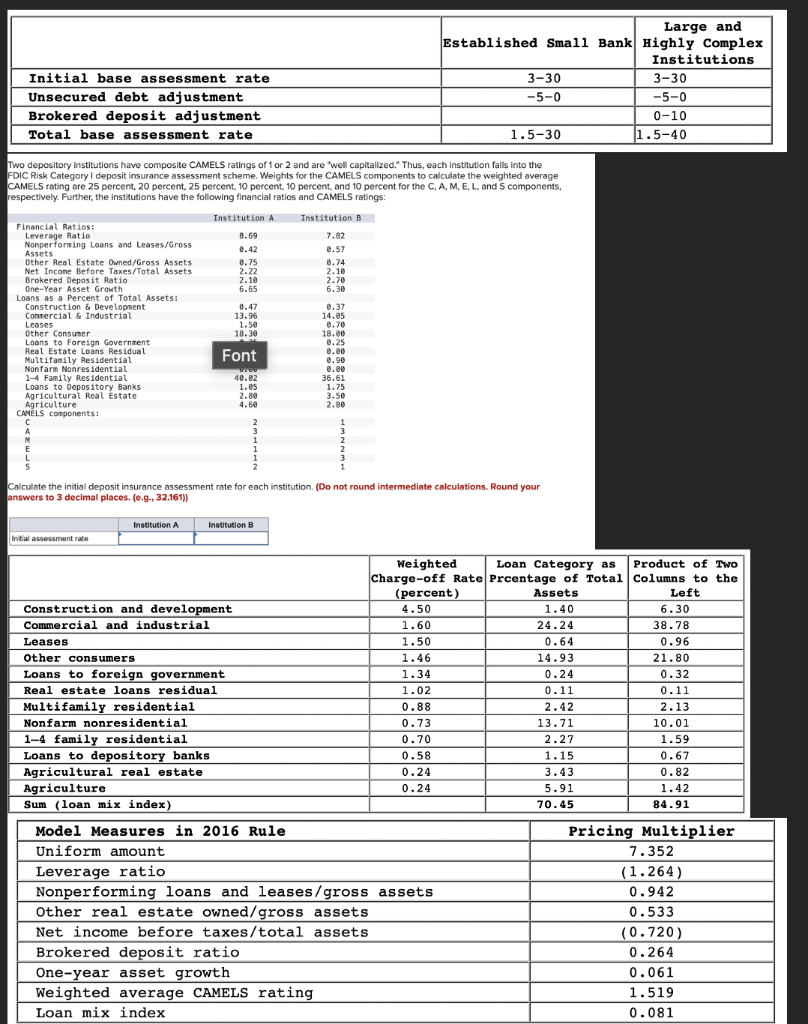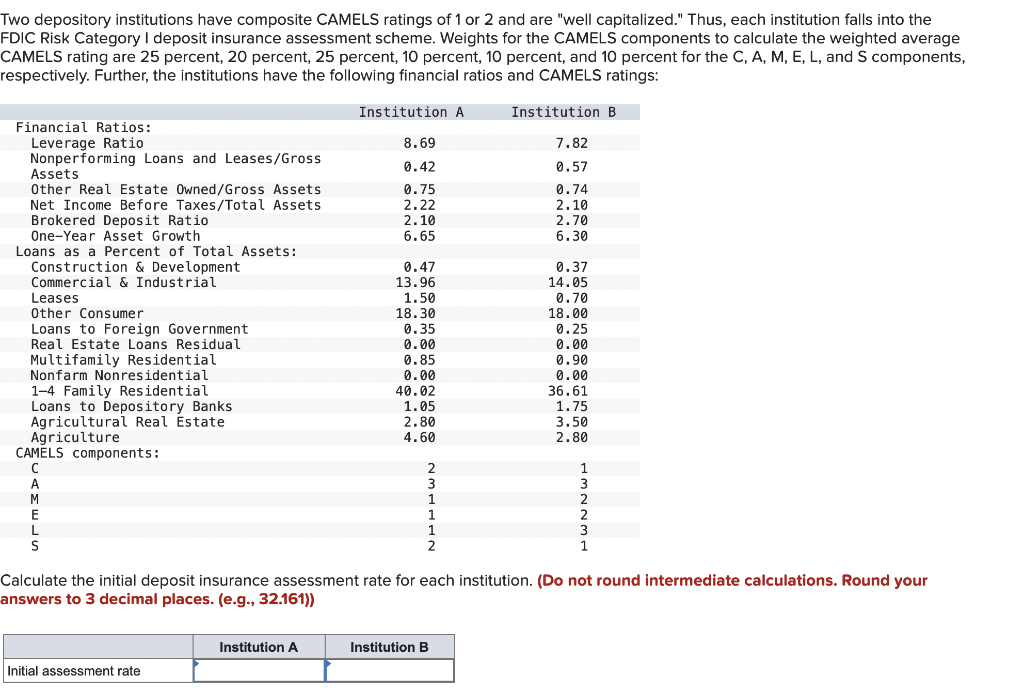

Initial base assessment rate Unsecured debt adjustment Brokered deposit adjustment Total base assessment rate Large and Established Small Bank Highly Complex Institutions 3-30 3-30 -5-0 -5-0 0-10 1.5-30 1.5-40 Two depository institutions have composite CAMELS ratings of 1 or 2 and are well capitalized." Thus, each institution falls into the 1 FDIC Risk Category I deposit insurance assessment scheme. Weights for the CAMELS components to calculate the weighted average CAMELS rating are 25 percent, 20 percent. 25 percent, 10 percent, 10 percent, and 10 percent for the C, A, M. E, L, and components, respectively. Further, the institutions have the following financial ratios and CAMELS ratings: Institution A Institution B Financial Ratios Leverage Ratio 8.69 7.82 Nonperforming Loans and Leases/Gross Assets 8.42 8.57 Other Real Estate Owned/Gross Assets 0.75 0.74 Net Income Before Taxes/Total Assets 2.22 2.10 Brokered Deposit Ratio 2.10 2.70 One-Year Asset Growth 6.65 6.30 Loans as a Percent of Total Assets: Construction & Development 0.47 0.37 Consercial & Industrial 13.96 14.05 Leases 1.50 0.70 Other Consumer 18.30 18.00 Loans to Foreign Government 0.25 Real Estate Loans Residual 0.80 Multifamily Residential Font 0.90 Nonfarm Nonresidential 0.00 1-4 Family Residential 40.82 36.61 Loans to Depository Banks 1.25 1.75 Agricultural Real Estate 2.80 3.50 Agriculture 4.60 2.80 CAMELS components: C 2 1 A L 5 Calculate the initial deposit insurance assessment rate for each institution. (Do not round intermediate calculations. Round your answers to 3 decimal places. (e.g., 32.161)) Institution A Institution B Initial assessment rate Weighted Loan Category as Product of Two Charge-off Rate Prcentage of Total Columns to the (percent) Assets Left Construction and development 4.50 1.40 6.30 Commercial and industrial 1.60 24.24 38.78 Leases 1.50 0.64 0.96 Other consumers 1.46 14.93 21.80 1:2 Loans to foreign government 1.34 0.24 0.32 Real estate loans residual 1.02 0.11 0.11 Multifamily residential 0.88 2.42 2.13 Nonfarm nonresidential -- 0.73 13.71 10.01 1-4 family residential 0.70 2.27 1.59 Loans to depository banks 0.58 1.15 0.67 Agricultural real estate 0.24 3.43 0.82 Agriculture 0.24 5.91 1.42 Sum (loan mix index) 70.45 84.91 Model Measures in 2016 Rule Pricing Multiplier Uniform amount 7.352 Leverage ratio (1.264) Nonperforming loans and leases/gross assets 0.942 Other real estate owned/gross assets 0.533 Net income before taxes/total assets (0.720) Brokered deposit ratio 0.264 One-year asset growth 0.061 Weighted average CAMELS rating 1.519 Loan mix index 0.081 Two depository institutions have composite CAMELS ratings of 1 or 2 and are "well capitalized." Thus, each institution falls into the FDIC Risk Category I deposit insurance assessment scheme. Weights for the CAMELS components to calculate the weighted average CAMELS rating are 25 percent, 20 percent, 25 percent, 10 percent, 10 percent, and 10 percent for the C, A, M, E, L, and S components, respectively. Further, the institutions have the following financial ratios and CAMELS ratings: Institution A Institution B 8.69 7.82 0.57 0.42 0.75 2.22 2.10 6.65 0.74 2.10 2.70 6.30 0.47 13.96 0.37 14.05 Financial Ratios: Leverage Ratio Nonperforming Loans and Leases/Gross Assets Other Real Estate Owned/Gross Assets Net Income Before Taxes/Total Assets Brokered Deposit Ratio One-Year Asset Growth Loans as a Percent of Total Assets: act Construction & Development Commercial & Industrial Other Consumer Loans to Foreign Government Real Estate Loans Residual Multifamily Residential Nonfarm Nonresidential 1-4 Family Residential Loans to Depository Banks Agricultural Real Estate Agriculture CAMELS components: Leases 1.50 0.70 18.30 0.35 0.00 0.85 0.00 40.02 1.05 2.80 4.60 18.00 0.25 0.00 0.90 0.00 36.61 1.75 3.50 2.80 2 3 1 1 1 2 E 1 S PWNNWP Calculate the initial deposit insurance assessment rate for each institution. (Do not round intermediate calculations. Round your answers to 3 decimal places. (e.g., 32.161)) Institution A Institution B Initial assessment rate Initial base assessment rate Unsecured debt adjustment Brokered deposit adjustment Total base assessment rate Large and Established Small Bank Highly Complex Institutions 3-30 3-30 -5-0 -5-0 0-10 1.5-30 1.5-40 Two depository institutions have composite CAMELS ratings of 1 or 2 and are well capitalized." Thus, each institution falls into the 1 FDIC Risk Category I deposit insurance assessment scheme. Weights for the CAMELS components to calculate the weighted average CAMELS rating are 25 percent, 20 percent. 25 percent, 10 percent, 10 percent, and 10 percent for the C, A, M. E, L, and components, respectively. Further, the institutions have the following financial ratios and CAMELS ratings: Institution A Institution B Financial Ratios Leverage Ratio 8.69 7.82 Nonperforming Loans and Leases/Gross Assets 8.42 8.57 Other Real Estate Owned/Gross Assets 0.75 0.74 Net Income Before Taxes/Total Assets 2.22 2.10 Brokered Deposit Ratio 2.10 2.70 One-Year Asset Growth 6.65 6.30 Loans as a Percent of Total Assets: Construction & Development 0.47 0.37 Consercial & Industrial 13.96 14.05 Leases 1.50 0.70 Other Consumer 18.30 18.00 Loans to Foreign Government 0.25 Real Estate Loans Residual 0.80 Multifamily Residential Font 0.90 Nonfarm Nonresidential 0.00 1-4 Family Residential 40.82 36.61 Loans to Depository Banks 1.25 1.75 Agricultural Real Estate 2.80 3.50 Agriculture 4.60 2.80 CAMELS components: C 2 1 A L 5 Calculate the initial deposit insurance assessment rate for each institution. (Do not round intermediate calculations. Round your answers to 3 decimal places. (e.g., 32.161)) Institution A Institution B Initial assessment rate Weighted Loan Category as Product of Two Charge-off Rate Prcentage of Total Columns to the (percent) Assets Left Construction and development 4.50 1.40 6.30 Commercial and industrial 1.60 24.24 38.78 Leases 1.50 0.64 0.96 Other consumers 1.46 14.93 21.80 1:2 Loans to foreign government 1.34 0.24 0.32 Real estate loans residual 1.02 0.11 0.11 Multifamily residential 0.88 2.42 2.13 Nonfarm nonresidential -- 0.73 13.71 10.01 1-4 family residential 0.70 2.27 1.59 Loans to depository banks 0.58 1.15 0.67 Agricultural real estate 0.24 3.43 0.82 Agriculture 0.24 5.91 1.42 Sum (loan mix index) 70.45 84.91 Model Measures in 2016 Rule Pricing Multiplier Uniform amount 7.352 Leverage ratio (1.264) Nonperforming loans and leases/gross assets 0.942 Other real estate owned/gross assets 0.533 Net income before taxes/total assets (0.720) Brokered deposit ratio 0.264 One-year asset growth 0.061 Weighted average CAMELS rating 1.519 Loan mix index 0.081 Two depository institutions have composite CAMELS ratings of 1 or 2 and are "well capitalized." Thus, each institution falls into the FDIC Risk Category I deposit insurance assessment scheme. Weights for the CAMELS components to calculate the weighted average CAMELS rating are 25 percent, 20 percent, 25 percent, 10 percent, 10 percent, and 10 percent for the C, A, M, E, L, and S components, respectively. Further, the institutions have the following financial ratios and CAMELS ratings: Institution A Institution B 8.69 7.82 0.57 0.42 0.75 2.22 2.10 6.65 0.74 2.10 2.70 6.30 0.47 13.96 0.37 14.05 Financial Ratios: Leverage Ratio Nonperforming Loans and Leases/Gross Assets Other Real Estate Owned/Gross Assets Net Income Before Taxes/Total Assets Brokered Deposit Ratio One-Year Asset Growth Loans as a Percent of Total Assets: act Construction & Development Commercial & Industrial Other Consumer Loans to Foreign Government Real Estate Loans Residual Multifamily Residential Nonfarm Nonresidential 1-4 Family Residential Loans to Depository Banks Agricultural Real Estate Agriculture CAMELS components: Leases 1.50 0.70 18.30 0.35 0.00 0.85 0.00 40.02 1.05 2.80 4.60 18.00 0.25 0.00 0.90 0.00 36.61 1.75 3.50 2.80 2 3 1 1 1 2 E 1 S PWNNWP Calculate the initial deposit insurance assessment rate for each institution. (Do not round intermediate calculations. Round your answers to 3 decimal places. (e.g., 32.161)) Institution A Institution B Initial assessment rate








